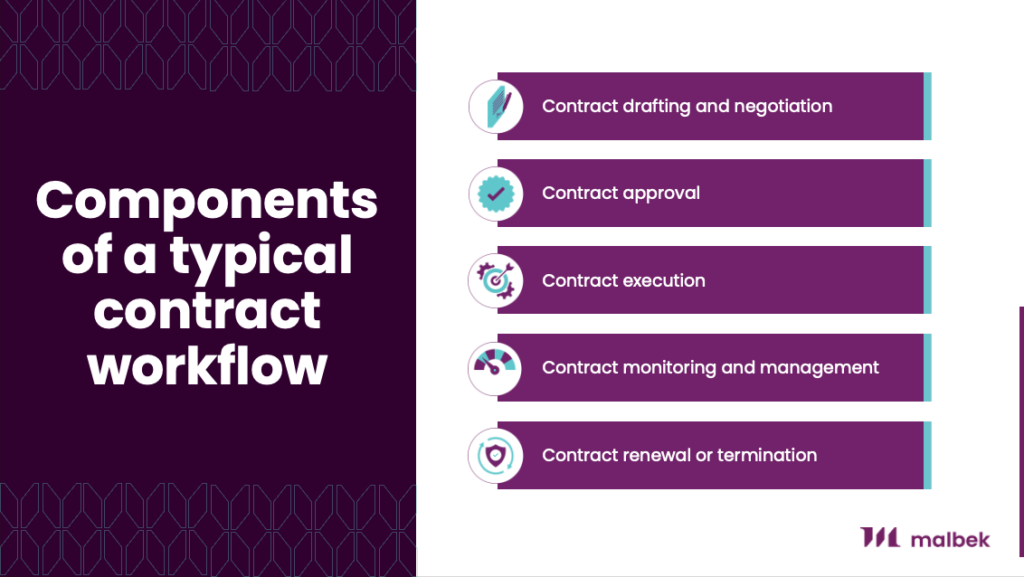Contract Management Workflow: The Power of Workflow Automation
Did you know that in almost 40% of organizations, it’s unclear who is actually responsible for contract management workflow? That’s a staggering statistic that shows just how disorganized contract processes are in many companies. The truth is, that effectively managing the contract workflow management is critical for any business that operates based on formal agreements with partners, suppliers, customers, and employees.
An optimized process – from request and creation to negotiation, approval, and execution – ensures that business is done quickly, risks are mitigated, and bottlenecks are minimized. It clarifies commitments and contract renewals, reducing costs and lost revenue. Yet still, in most organizations, the contract management lifecycle is hampered by manual, disjointed processes that could be more efficient, cause delays, and create legal risks.
With AI-powered contract lifecycle management (CLM) solutions, companies can finally transform this critical business process. In this article, we are going to discuss, how automating and streamlining the workflow can accelerate business operations and compliance.
The Typical Contract Management Workflow Process
A contract management workflow is the sequence of steps involved in managing contracts from initial request through drafting, negotiation, approval, execution, management of obligations, and renewal/termination, with the main objective of ensuring that agreements are implemented properly and efficiently to mitigate risks and maximize business results.
While specifics vary by industry and organization, the typical contract management workflow process tends to follow a standard set of steps that have remained pretty much the same for decades:
- The contract workflow begins with the receipt and routing of requests, initiating a contract based on a specific business need, such as finding a new supplier or hiring an employee. The contract then moves to the drafting stage, where the legal teams pull together agreement details, clauses, and terms based on past precedents.
- The workflow progresses into cycles of redlining, negotiations, and internal/external reviews and approvals as stakeholders scrutinize and haggle over language. Once all necessary approvals have been obtained, the fully negotiated contract is signed and executed manually or electronically.
- After execution, the contract management workflow continues by tracking deliverables, milestones, and deadlines set out in the agreement. Analysis and reporting are also required at this stage to ensure compliance and sound planning.
- Finally, the contract workflow culminates in renewals or terminations once the end date is reached, potentially initiating a new contract cycle if the relationship continues.

Common Pain Points and Inefficiencies
Even with defined workflows, manual and disconnected contract management processes are full of bottlenecks and risks. Simple requests get lost in black holes in the inbox. Draft contracts get trapped in revision cycles with little transparency. High-value deals stall as they await approval from the overburdened legal team. Once signed, commitments are not honored, and automatic renewal deadlines are ignored until costly fees or litigation ensue.
Organizations that rely too heavily on Microsoft Word, email, and shared drives cannot efficiently collaborate on contracts, oversee management, or report on portfolio performance, cash flow, and risk. These methods prevent organizations from efficiently and competently managing their key business agreements.
The Power of Workflow Automation
To overcome the inefficiencies and risks of disconnected, manual contract management workflow processes, companies are increasingly turning to contract lifecycle management (CLM) platforms. CLM solutions provide centralized repositories and automated workflows that streamline and govern every stage from intake to renewal.
By consolidating the contract management workflow process into a single system, CLM software eliminates the chaos caused by juggling contracts in emails, shared drives, and other isolated tools. Users can initiate new contract requests via automated inbound portals, with requests dynamically routed to the appropriate teams and subject matter experts based on configured rules.
AI-powered CLM systems use proven clause libraries and templates to speed up the creation of contracts. The contract management workflow diagram guides through AI-assisted redlining, negotiation, and routing at the click of a button to the required stakeholders for review and electronic approval based on pre-configured business rules.
Once executed through the integrated electronic signature capabilities, CLM provides full traceability of who approved what and when. Workflow continues with automated commitment tracking, renewal deadline notifications, and robust reporting dashboards.
By automating and streamlining the contract management workflow in this way, CLM software offers huge benefits:
- Faster contract closures and shorter cycle times
- Reduced manual errors and risks
- Greater compliance with internal guidelines and external regulations
- Improved collaboration and version control
- Full insight into portfolios, bottlenecks, and risks
- Reduced costs and resource requirements
Whether it’s setting up proactive guardrails or streamlining downstream processes, comprehensive CLM solutions enable organizations to optimize their contract management workflows to get the most value for their business.
Setting Up Contract Management Workflow Automation
Implementing CLM software with robust, automated contract management workflows starts by mapping out all stakeholders and defining their roles. Who can initiate contact requests? Who needs to approve different types of agreements based on risk, value, or business unit? Which team owns which contract templates and language?
Once responsibilities are clear, the next step is to load pre-approved clause and template libraries into the CLM repository. These standardized building blocks enable self-service contract creation while enforcing the approved playbooks.
Approval workflows are then configured with intuitive drag-and-drop tools to reflect your organization’s specific processes and policies. This can include automatically routing contracts based on variables such as dollar value, counterparty, or conditions for higher-level approvals.
Other automated workflow rules can also be defined, such as setting permissions for viewing/editing access, setting up automatic reminders for commitments, or providing built-in e-signature sequences based on the contract type.
With a well-thought-out, comprehensive implementation, the CLM system controls the entire contract management workflow through defined rules, roles, and automated processes.
Key Features to Look for in CLM Workflow Automation
When evaluating contract lifecycle management (CLM) solutions to automate and optimize your contract management workflow, there are some important features you should look out for:
1. Template and Clause Library:
A centralized repository of pre-approved, customizable templates and clauses is table stakes. This allows for controlled authoring and self-service creation of agreements while enforcing approved organizational playbooks and language. Robust CLM platforms provide intelligent clause libraries with contextual recommendations.
2. Drag-and-Drop Workflow Builder:
The ability to visually map and configure automated workflow paths through intuitive, no-code/low-code designers. This enables modeling of the entire contract lifecycle based on an organization’s specific processes, stakeholders, approval hierarchies, and business rules around dollar values, risk factors, agreement types, etc.
3. Configured Approval Routing:
Closely linked to the workflow builder, CLM solutions should allow multi-tiered approvals to be defined and automatically triggered based on the workflow path. This ensures that agreements are reviewed and approved according to governance requirements before execution.
4. eSignature Integration:
Seamless connectivity with leading eSignature providers such as DocuSign eliminates the bottlenecks and risks of manual signatures. Electronic signatures speed up the closing of deals while providing a complete audit trail.
5. Contract Obligation Tracking:
Once a contract is signed, automatic alerts and notifications keep stakeholders informed of upcoming deadlines, milestones, renewal periods and other critical dates specified in the agreement. This reduces the risk of missed commitments, automatic extensions, and breaches of contract.
6. Reporting and Analytics:
Comprehensive reporting capabilities with data visualization dashboards are essential for monitoring and optimizing the contract management workflow. Metrics like cycle times, potential bottlenecks, agreement volumes, risks, and financials provide full visibility.
7. AI & Machine Learning Capabilities:
Artificial intelligence is increasingly being integrated into CLM platforms to optimize workflows through intelligent features such as automatic metadata extraction, advanced OCR, risk/deviation identification, and guided creation recommendations.
By focusing their assessment on these core capabilities, organizations can implement CLM solutions that truly automate and govern every stage of their contract management workflows – increasing business velocity while ensuring compliance and mitigating risk.
By focusing their assessment on these core capabilities, organizations can implement CLM solutions that truly automate and govern every stage of their contract management workflows – increasing business velocity while ensuring compliance and mitigating risk.
AI and Intelligent Automation
By integrating artificial intelligence throughout the contract lifecycle management, leading platforms are revolutionizing workflow automation, enhancing efficiency, and providing valuable insights.
Let’s see what AI brings to the table when it comes to automating contract management workflows:
Workflow optimization: AI optimizes the initial contract request process by automatically populating metadata fields with important information such as key terms and dates, speeding up triage and improving routing accuracy through AI-driven contextual understanding.
Workflow optimization:
AI optimizes the initial contract request process by automatically populating metadata fields with important information such as key terms and dates, speeding up triage and improving routing accuracy through AI-driven contextual understanding.
AI-driven triage and routing:
Using AI to triage and route contract requests ensures fast and efficient routing to the right team or person because AI can understand the context and prioritize accordingly.
Support with drafting and redlining:
When drafting and redrafting contracts, AI helps by understanding the context and business intent, suggesting optimal clause wording, and flagging deviations to simplify compliance and negotiation processes.
Real-time risk identification:
AI improves risk management by automatically extracting provisions to identify potential issues in real-time, minimizing omissions and enabling proactive issue resolution.
Improved modeling of the approval workflow:
AI dynamically configures approval workflows based on variables such as dollar values and risk factors and triggers approvals through semantic understanding, optimizing process efficiency and compliance.
Post-signature monitoring and notification:
After signing, AI monitors commitment and renewal deadlines and automatically triggers notifications to avoid missed deadlines and ensure compliance with contractual commitments.
AI-driven Analytics for actionable insights:
By processing large amounts of data quickly, AI-driven analytics deliver actionable insights on contract velocity, finance, and risk that improve decision-making and resource allocation while strengthening compliance.
How Can a CLM Help in Contract Workflow Automation?
The transformative power of intelligent automation in contract lifecycle management (CLM) cannot be overstated. By automating and streamlining workflows, organizations can eliminate common inefficiencies, mitigate risk, and increase overall efficiency – with benefits ranging from faster contract closings to improved compliance and lower costs.
To learn more about how Malbek’s automation capabilities can improve your current contract management workflow and transform it from an undervalued function to one of your organization’s greatest assets, book a demo with us.
FAQ – Contract Management Workflow
What is a contract management workflow?
A contract management workflow is a structured sequence of processes that ensures the efficient handling of contracts, from initiation and review to execution and ongoing performance tracking. It incorporates key stages such as drafting, compliance checks, signature gathering, and lifecycle management, ensuring seamless and compliant operations.
How does workflow automation improve contract management?
Workflow automation significantly enhances contract management by:
- Reducing errors: Automated tools minimize manual data entry mistakes.
- Saving time: Streamlining repetitive tasks like approvals and notifications.
- Enhancing compliance: Ensuring adherence to regulatory and organizational standards.
- Improving visibility: Centralized tracking of contract statuses and deadlines.
How does automation enhance the contract negotiation workflow?
Automation optimizes the contract negotiation workflow by:
- Change tracking: Maintaining version control throughout edits.
- Streamlined communication: provides centralized platforms for real-time discussions.
- Reduced delays: Automated reminders and approvals expedite decisions.
- Compliance management: Enforced standards during negotiations.
- Clause Library: Provides a set of approved addendums that can be used during negotiation.
What are the stages of the contract management cycle?
The contract management cycle involves several, sometimes overlapping stages:
- Planning: Defining requirements and preparing contract types.
- Drafting: Creating the initial contract document.
- Negotiation: Collaborating to finalize terms.
- Approval: Gaining necessary authorizations.
- Execution: Signing and implementing the contract.
- Performance monitoring: Ensuring adherence to obligations.
- Renewal or closure: Managing contract outcomes.
What is the role of OCR in contract management?
OCR (Optical Character Recognition) technology aids contract management by digitizing paper documents, making their content searchable, reducing errors associated with manual entry, and simplifying audits through easy document retrieval.
This way OCR enables ML and AI to gather contract intelligence from any document.
What is a contract management strategy?
A contract management strategy is a systematic approach to managing contracts efficiently throughout their lifecycle. It involves:
- Defining goals: Aligning contract objectives with business priorities.
- Standardized processes: Establish consistent workflows.
- Roles: Assignment of responsibilities & stakeholders.
- Performance metrics & monitoring: Establish KPIs for objective & consistent evaluation.
- Technology utilization: Adopting tools like contract workflow software.
What is contract workflow software, and why is it valuable?
Contract workflow software is a specialized tool for managing contract processes, offering:
- Automation: Streamlining repetitive tasks.
- Collaboration: Enabling stakeholder input.
- Performance tracking: Monitoring progress and deadlines.
- Compliance & risk mitigation: Ensuring adherence to standards and policies.
Contract lifecycle (CLM) platforms like Malbek can assist you in creating an effective workflow throughout your organization.








